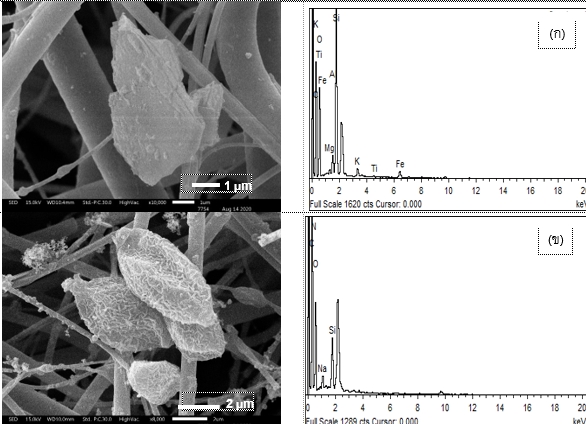Health Risk Assessment of Exposure PM2.5 from Industrial Area in Pluak Daeng district, Rayong province
Keywords:
Fine particulate matter, Air pollution, Health risk assessment, Hazard quotient (HQ)Abstract
The inhalation of fine particles (PM2.5) has been associated with human health problems, which is affect to respiratory system and mortality. This research aims to investigate PM2.5 released from industrial area of Pluak Daeng district, Rayong province to assess the human health risk. PM2.5 samples were collected on quartz fiber filters using a mini volume air sampler during wet and dry seasons. It was found that the average PM2.5 concentrations in wet season (38.8±25.2 µg/m3) were lower than dry season (52.7±33.9 µg/m3). When wet season were compared with dry season, the average PM2.5 concentrations were not significantly different (p>0.05). Moreover, the health risk assessments of exposure PM2.5 were calculated by Hazard quotient (HQ), the results found that the average HQ values of children in wet and dry season were higher than adult and exceeded 1.0, indicating the potential health risks. Consequently, in the long term, children will uptake more PM2.5 into the respiratory tract than adults. The result of morphology and elemental composition study reveals that PM2.5 were complexed chemistries that usually contained oxygen, iron, magnesium, aluminum, potassium or sodium. It could be released from industrial area.
References
กองจัดการคุณภาพอากาศและเสียง กรมควบคุมมลพิษ, แผนปฏิบัติการขับเคลื่อนวาระแห่งชาติ การแก้ไขปัญหามลพิษด้านฝุ่นละออง. กรุงเทพฯ: กรมควบคุมมลพิษกระทรวงทรัพยากรธรรมชาติและสิ่งแวดล้อม; 2562. หน้า 5-13. 48 หน้า.
World Health Organization (WHO). Health risk of particulate matter from long-range transboundry air pollution [Internet]. Copenhagen, Denmark; 2006 [Cites 20 October 2020]. Assessed from; http://www.euro.who.int/pubrequest.
Koplitz SN, Jacob DJ, Sulprizio MP, Myllyvirta L and Reid C. Burden of Disease from Rising Coal-fired Power plant Emissions in Southeast Asia. Environ Sci Technol. 2017; 51: 1467-1476.
Narita D, Kim Oanh NT, Sato K, Hao M, Permadi DA, Ha Chi NN, Ratanajaratroj T and Pawarmart I. Pollution characteristics and policy actions on fine particulate matter in a growing Asian economy: The case of Bangkok metropolitan region. Atmosphere. 2019; 10(227): 3-18.
Hien TT, Thien Chi ND, Nguyen NT, Vinh LX, Takenaka N and Huy DH. Current status of fine particulate matter (PM2.5) in Vietnam’s most populous city, Ho Chi Minh city. Aerosol Air Qual Res. 2019; 19: 2239-2251.
ธิดารัตน์ ผลพิบูลย์, อิสรีย์ฐิกา ชัยสวัสดิ์ และอนุวัตร รุ่งพิสุทธิพงษ์. ภัยในหน้าหนาวจากฝุ่นละอองขนาดเล็ก (PM2.5). วารสารวิชาการมหาวิทยาลัยอีสเทิร์นเอเชีย ฉบับวิทยาศาสตร์และเทคโนโลยี. 2557; 8(1): 40-46.
Li R, Zhou R and Zhang J. Function of PM2.5 in the pathogenesis of lung cancer and chronic airway inflammatory diseases (Review). Oncol. Lett. 2018; 15: 7506-7514.
Li T, Hu R, Chen Z, Huang M, Li Q-Y, Huang S-X, Zhu Z and Zhou L-F. PM2.5: the culprit for chronic lung diseases in China. CDTM. 2018; 4: 176-186.
World Health Organization-International Agency for Research on Cancer (WHO-IARC). Outdoor Air pollution. The International Agency for Research on Cancer, France: China Foto Press; 2016. 177 p.
สำนักงานคณะกรรมการนโยบายเขตพัฒนาพิเศษภาคตะวันออก (สกพอ.) เขตพัฒนาพื้นที่ระเบียงเศรษฐกิจพิเศษภาคตะวันออก (Eastern Economic Corridor (EEC) office) [Internet]. Bang Kok; 2019 [Cites 20 November 2020]. Assessed from; https://eeco.or.th/th/promotional-zone.
กรมโรงงานอุตสาหกรรม. ข้อมูลโรงงานอุตสาหกรรมสำหรับเจ้าหน้าที่: ข้อมูลสรุปในภาพรวมของอำเภอปลวกแดง จังหวัดระยอง [Internet]. Rayong; 2020 [Cites 15 November 2020]. Assessed from; reg.diw.go.th/executive/Amp3.asp?amp=6&prov=21.
Adamiec E and Jarosz-Krzemińska. Human health risk assessment associated with contaminants in the finest fraction of sidewalk dust collected in proximity to trafficked roads. Sci Rep. 2019; 9(16364): doi; 10.1038/s41598-019-52815-0.
Olufemi AC, Mji A and Mukhola MS. Health risks of exposure to air pollutants among students in schools in the vicinities of coal mines. Energ Explor Exploit. 2019; 37(6): 1638-11656.
Hamastia A, Hermawati E, Marina R and Andrian R. Estimated analysis on environmental health risk of 2.5 microns particulate matter to urban communities in South Jakarta. Indian J Public Health Res Dev. 2019; 10(2): 332-337.
Liang B, Li X-L, Ma K and Liang S-X. Pollution characteristics of metal pollutants in PM2.5 and comparison of risk on human health in heating and non-heating seasons in Baoding, China. Ecotoxicol Environ Saf. 2019; 170: 166-171.
Mo Z, Wang Z, Mao G, Pan X, Wu L, Xu P, Chen S, Wang A, Zhang Y, Luo J, Ye X, Wang X, Chen Z and Lou X. Characterization and health risk assessment of PM2.5-bound polycyclic aromatic hydrocarbons in 5 urban cities of Zhejiang province, China. Sci Rep. 2019; 9(1): 7296. DOI: 10.1038/s41598-019-43557-0.
Labrada-Delgado G, Aragon-Pina A, Campos-Ramos A, Castro-Romero T, Amadór-Munoz O and Villalobos-Pietrini R. Chemical and morphological characterization of PM2.5 collected during MILAGRO campaign using scanning electron microscopy. Atmos Pollut Res. 2012; 3: 289-300.
Xue H, Liu G, Zhang H, Hu R and Wang X. Elemental composition, morphology and sources of fine particulates (PM2.5) in Hefei city, China. Aerosol Air Qual Res. 2019; 19: 1688-1696.
Chithra VS and Shiva Nagendra SM. Impact of outdoor meteorology on indoor PM10, PM2.5 and PM1 concentrations in a naturally ventilated classroom. Urban Clim. 2014; 10: 77-91.
U.S. EPA (United States-Environmental Protection Agency). Exposure Factors Handbook: 2011 edition; National Center for Environmental Assessment [Internet]. Washington, DC; 2011 [Cites 20 December 2020]. Assessed from; http://www.epa.gov/ncea/efh.
Miller MD, Marty MA, Arcus A, Brown J, Morry D, Sandy M. Differences between Children and Adults: implications for Risk Assessment at California EPA. Int J Toxicol. 2002; 21: 403–418.
Li CY, Ding M, Yang Y, Zhang P, Li Y, Wang Y, Huang L, Yang P, Wang M, Sha X, Xu Y, Guo C and Shan Z. Portrait and classification of individual haze particulates. J Environ Prot. 2016; 7: 1355-1379.

Downloads
Published
How to Cite
Issue
Section
License
Copyright (c) 2021 Naresuan Phayao Journal

This work is licensed under a Creative Commons Attribution-NonCommercial-NoDerivatives 4.0 International License.
ผู้นิพนธ์ต้องรับผิดชอบข้อความในบทนิพนธ์ของตน มหาวิทยาลัยพะเยาไม่จำเป็นต้องเห็นด้วยกับบทความที่ตีพิมพ์เสมอไป ผู้สนใจสามารถคัดลอก และนำไปใช้ได้ แต่จะต้องขออนุมัติเจ้าของ และได้รับการอนุมัติเป็นลายลักษณ์อักษรก่อน พร้อมกับมีการอ้างอิงและกล่าวคำขอบคุณให้ถูกต้องด้วย
The authors are themselves responsible for their contents. Signed articles may not always reflect the opinion of University of Phayao. The articles can be reproduced and reprinted, provided that permission is given by the authors and acknowledgement must be given.







